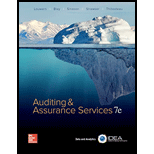
Auditing & Assurance Services (Auditing and Assurance Services)
7th Edition
ISBN: 9781259573286
Author: Timothy J Louwers, Allen Blay, David Sinason Associate Professor, Jerry R Strawser, Jay C. Thibodeau Associate Professor
Publisher: McGraw-Hill Education
expand_more
expand_more
format_list_bulleted
Question
Chapter 11, Problem 1RC
To determine
Examine four primary periods in an audit examination and the task and activities that occur in each.
Expert Solution & Answer
Explanation of Solution
Audit Examination: Audit examination is an organized and independent work to examine sufficient and appropriate information, and evidence from the books of accounts, statutory records, documents, and voucher of an organization.
Four primary periods in an audit examination are as follows:
- Beginning of the year: An auditor checks the internal control of entity, test the effectiveness of a control, collect material information, and misstatements.
- Year-End date: Auditors perform further procedures, gather sufficient, and appropriate evidence related to financial statements, and internal control; review all the documents related to audit; preparation to express an opinion on the financial statements, and internal control of entity.
- Date of auditors’ report: From audit completion date to audit release date; it is very short, significant, and challenging time for auditors because time for collecting more evidence, and time to be alert is less.
- Audit report release date: After the audit report release date, and issuance of the client’s financial statement, some issues and information come to the auditors’; auditors should be attentive for further proceed.
Want to see more full solutions like this?
Subscribe now to access step-by-step solutions to millions of textbook problems written by subject matter experts!
Students have asked these similar questions
Can you solve this financial accounting problem using accurate calculation methods?
Can you explain the process for solving this financial accounting question accurately?
Hello tutor please given General accounting question answer do fast and properly explain all answer
Chapter 11 Solutions
Auditing & Assurance Services (Auditing and Assurance Services)
Ch. 11 - Prob. 1RCCh. 11 - Prob. 2RCCh. 11 - Prob. 3RCCh. 11 - What additional issues are involved with...Ch. 11 - Prob. 5RCCh. 11 - Prob. 6RCCh. 11 - Prob. 7RCCh. 11 - Prob. 8RCCh. 11 - Prob. 9RCCh. 11 - Prob. 10RC
Ch. 11 - Prob. 11RCCh. 11 - Prob. 12RCCh. 11 - Prob. 13RCCh. 11 - Prob. 14RCCh. 11 - Prob. 15RCCh. 11 - Prob. 16RCCh. 11 - Prob. 17RCCh. 11 - Prob. 18RCCh. 11 - Prob. 19RCCh. 11 - Prob. 20RCCh. 11 - Prob. 21RCCh. 11 - Prob. 22RCCh. 11 - Prob. 23RCCh. 11 - Prob. 24RCCh. 11 - Prob. 25RCCh. 11 - Prob. 26RCCh. 11 - Prob. 27RCCh. 11 - Prob. 28RCCh. 11 - Prob. 29RCCh. 11 - Prob. 30RCCh. 11 - Prob. 31MCQCh. 11 - Prob. 32MCQCh. 11 - Which of these substantive procedures is not used...Ch. 11 - Prob. 34MCQCh. 11 - Prob. 35MCQCh. 11 - Prob. 36MCQCh. 11 - Prob. 37MCQCh. 11 - Prob. 38MCQCh. 11 - Prob. 39MCQCh. 11 - Prob. 40MCQCh. 11 - Prob. 41MCQCh. 11 - Prob. 42MCQCh. 11 - Prob. 43MCQCh. 11 - Prob. 44MCQCh. 11 - Prob. 45MCQCh. 11 - Prob. 46MCQCh. 11 - Prob. 47MCQCh. 11 - Prob. 48MCQCh. 11 - Prob. 49MCQCh. 11 - Prob. 50MCQCh. 11 - Prob. 51MCQCh. 11 - Prob. 52EPCh. 11 - Prob. 53EPCh. 11 - Prob. 54EPCh. 11 - Prob. 55EPCh. 11 - Prob. 56EPCh. 11 - Prob. 57EPCh. 11 - Prob. 58EPCh. 11 - Prob. 59EPCh. 11 - Prob. 60EPCh. 11 - Prob. 64EPCh. 11 - Prob. 65EPCh. 11 - Prob. 66EPCh. 11 - Prob. 67EPCh. 11 - Prob. 68EPCh. 11 - Prob. 69EPCh. 11 - Prob. 70EPCh. 11 - Prob. 71EPCh. 11 - Prob. 72EPCh. 11 - Prob. 73EP
Knowledge Booster
Similar questions
arrow_back_ios
SEE MORE QUESTIONS
arrow_forward_ios
Recommended textbooks for you

 AccountingAccountingISBN:9781337272094Author:WARREN, Carl S., Reeve, James M., Duchac, Jonathan E.Publisher:Cengage Learning,
AccountingAccountingISBN:9781337272094Author:WARREN, Carl S., Reeve, James M., Duchac, Jonathan E.Publisher:Cengage Learning, Accounting Information SystemsAccountingISBN:9781337619202Author:Hall, James A.Publisher:Cengage Learning,
Accounting Information SystemsAccountingISBN:9781337619202Author:Hall, James A.Publisher:Cengage Learning, Horngren's Cost Accounting: A Managerial Emphasis...AccountingISBN:9780134475585Author:Srikant M. Datar, Madhav V. RajanPublisher:PEARSON
Horngren's Cost Accounting: A Managerial Emphasis...AccountingISBN:9780134475585Author:Srikant M. Datar, Madhav V. RajanPublisher:PEARSON Intermediate AccountingAccountingISBN:9781259722660Author:J. David Spiceland, Mark W. Nelson, Wayne M ThomasPublisher:McGraw-Hill Education
Intermediate AccountingAccountingISBN:9781259722660Author:J. David Spiceland, Mark W. Nelson, Wayne M ThomasPublisher:McGraw-Hill Education Financial and Managerial AccountingAccountingISBN:9781259726705Author:John J Wild, Ken W. Shaw, Barbara Chiappetta Fundamental Accounting PrinciplesPublisher:McGraw-Hill Education
Financial and Managerial AccountingAccountingISBN:9781259726705Author:John J Wild, Ken W. Shaw, Barbara Chiappetta Fundamental Accounting PrinciplesPublisher:McGraw-Hill Education


Accounting
Accounting
ISBN:9781337272094
Author:WARREN, Carl S., Reeve, James M., Duchac, Jonathan E.
Publisher:Cengage Learning,

Accounting Information Systems
Accounting
ISBN:9781337619202
Author:Hall, James A.
Publisher:Cengage Learning,

Horngren's Cost Accounting: A Managerial Emphasis...
Accounting
ISBN:9780134475585
Author:Srikant M. Datar, Madhav V. Rajan
Publisher:PEARSON

Intermediate Accounting
Accounting
ISBN:9781259722660
Author:J. David Spiceland, Mark W. Nelson, Wayne M Thomas
Publisher:McGraw-Hill Education

Financial and Managerial Accounting
Accounting
ISBN:9781259726705
Author:John J Wild, Ken W. Shaw, Barbara Chiappetta Fundamental Accounting Principles
Publisher:McGraw-Hill Education